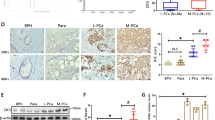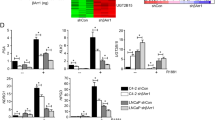Abstract
Androgen and the androgen receptor (AR) have important roles in prostate cancer (PCa) development, and androgen ablation has been the main therapeutic option for the treatment of PCa. However, the transition mechanism from androgen-dependent to -independent PCa after androgen depletion remains unclear. We investigated the distinct roles of small leucine zipper protein (sLZIP) in proliferation of androgen-dependent and -independent PCa cells. Cyclin D3 is known to interact with AR and attenuates the ligand-dependent function of AR in PCa cells. sLZIP regulates the transcription of cyclin D3 by binding directly to the AP-1 region in the cyclin D3 promoter. sLZIP represses AR transcriptional activity by interaction with AR that is phosphorylated by cyclin D3/cyclin-dependent kinase11p58, leading to the suppression of androgen-dependent proliferation of PCa cells. The expression level of sLZIP is elevated in androgen-independent PCa cells and advanced human prostate tumors. Knockdown of endogenous sLZIP suppresses proliferation of androgen-independent PCa cells. LNCaP cells transformed to androgen-independent PCa cells exhibit increased expressions of sLZIP and cyclin D3. Tumor formation is inhibited in nude mouse xenografts from two androgen-independent PCa cells that are stably transfected with sh-sLZIP. Our findings indicate that sLZIP negatively regulates AR transactivation in androgen-dependent PCa cells and functions as a positive regulator in tumor progression of androgen-independent PCa. sLZIP contributes to the malignant phenotype of PCa and constitutes a novel therapeutic target for human PCa.
This is a preview of subscription content, access via your institution
Access options
Subscribe to this journal
Receive 50 print issues and online access
$259.00 per year
only $5.18 per issue
Buy this article
- Purchase on Springer Link
- Instant access to full article PDF
Prices may be subject to local taxes which are calculated during checkout







Similar content being viewed by others
References
Nelson WG, De Marzo AM, Isaacs WB . Prostate cancer. N Engl J Med 2003; 349: 366–381.
Pienta KJ, Bradley D . Mechanisms underlying the development of androgen-independent prostate cancer. Clin Cancer Res 2006; 12: 1665–1671.
Tilley WD, Buchanan G, Hickey TE, Bentel JM . Mutations in the androgen receptor gene are associated with progression of human prostate cancer to androgen independence. Clin Cancer Res 1996; 2: 277–285.
Visakorpi T, Hyytinen E, Koivisto P, Tanner M, Keinanen R, Palmberg C et al. In vivo amplification of the androgen receptor gene and progression of human prostate cancer. Nat Genet 1995; 9: 401–406.
Gelmann EP . Molecular biology of the androgen receptor. J Clin Oncol 2002; 20: 3001–3015.
Heinlein CA, Chang C . Androgen receptor in prostate cancer. Endocr Rev 2004; 25: 276–308.
Olshavsky NA, Groh EM, Comstock CE, Morey LM, Wang Y, Revelo MP et al. Cyclin D3 action in androgen receptor regulation and prostate cancer. Oncogene 2008; 27: 3111–3121.
Lin DY, Fang HI, Ma AH, Huang YS, Pu YS, Jenster G et al. Negative modulation of androgen receptor transcriptional activity by Daxx. Mol Cell Biol 2004; 24: 10529–10541.
Cui J, Yang Y, Zhang C, Hu P, Kan W, Bai X et al. FBI-1 functions as a novel AR co-repressor in prostate cancer cells. Cell Mol Life Sci 2011; 68: 1091–1103.
Herzinger T, Reed SI . Cyclin D3 is rate-limiting for the G1/S phase transition in fibroblasts. J Biol Chem 1998; 273: 14958–14961.
Hleb M, Murphy S, Wagner EF, Hanna NN, Sharma N, Park J et al. Evidence for cyclin D3 as a novel target of rapamycin in human T lymphocytes. J Biol Chem 2004; 279: 31948–31955.
Reisman D, Thompson EA . Glucocorticoid regulation of cyclin D3 gene transcription and mRNA stability in lymphoid cells. Mol Endocrinol 1995; 9: 1500–1509.
Garcia-Morales P, Hernando E, Carrasco-Garcia E, Menendez-Gutierrez MP,, Saceda M, Martinez-Lacaci I . Cyclin D3 is down-regulated by rapamycin in HER-2-overexpressing breast cancer cells. Mol Cancer Ther 2006; 5: 2172–2181.
Zong H, Chi Y, Wang Y, Yang Y, Zhang L, Chen H et al. Cyclin D3/CDK11p58 complex is involved in the repression of androgen receptor. Mol Cell Biol 2007; 27: 7125–7142.
Kang H, Kim YS, Ko J . A novel isoform of human LZIP negatively regulates the transactivation of the glucocorticoid receptor. Mol Endocrinol 2009; 23: 1746–1757.
Kang H, Jang SW, Ko J . Human sLZIP induces migration and invasion of cervical cancer cells via expression of matrix metalloproteinase-9. J Biol Chem 2011; 286: 42072–42081.
Jang SY, Jang SW, Ko J . Regulation of ADP-ribosylation factor 4 expression by small leucine zipper protein and involvement in breast cancer cell migration. Cancer Lett 2011; 314: 185–197.
Lu S, Tsai SY, Tsai MJ . Molecular mechanisms of androgen-independent growth of human prostate cancer LNCaP-AI cells. Endocrinology 1999; 140: 5054–5059.
Igawa T, Lin FF, Lee MS, Karan D, Batra SK, Lin MF . Establishment and characterization of androgen-independent human prostate cancer LNCaP cell model. Prostate 2002; 50: 222–235.
Galderisi U, Jori FP, Giordano A . Cell cycle regulation and neural differentiation. Oncogene 2003; 22: 5208–5219.
Heemers HV, Tindall DJ . Androgen receptor (AR) coregulators: a diversity of functions converging on and regulating the AR transcriptional complex. Endocr Rev 2007; 28: 778–808.
Horoszewicz JS, Leong SS, Kawinski E, Karr JP, Rosenthal H, Chu TM et al. LNCaP model of human prostatic carcinoma. Cancer Res 1983; 43: 1809–1818.
Compagno D, Merle C, Morin A, Gilbert C, Mathieu JR, Bozec A et al. SIRNA-directed in vivo silencing of androgen receptor inhibits the growth of castration-resistant prostate carcinomas. PLoS One 2007; 2: e1006.
Chen CD, Welsbie DS, Tran C, Baek SH, Chen R, Vessella R et al. Molecular determinants of resistance to antiandrogen therapy. Nat Med 2004; 10: 33–39.
Li Y, Wang L, Zhang M, Melamed J, Liu X, Reiter R et al. LEF1 in androgen-independent prostate cancer: regulation of androgen receptor expression, prostate cancer growth, and invasion. Cancer Res 2009; 69: 3332–3338.
Acknowledgements
This work was supported by a Korea University Grant and the Basic Research Laboratory Program (2009–0087099) through the National Research Foundation of Korea (NRF) funded by the Ministry of Education, Science and Technology.
Author information
Authors and Affiliations
Corresponding author
Ethics declarations
Competing interests
The authors declare no conflict of interest.
Additional information
Supplementary Information accompanies this paper on the Oncogene website
Supplementary information
Rights and permissions
About this article
Cite this article
Kim, Y., Kim, J., Jang, SW. et al. The role of sLZIP in cyclin D3-mediated negative regulation of androgen receptor transactivation and its involvement in prostate cancer. Oncogene 34, 226–236 (2015). https://doi.org/10.1038/onc.2013.538
Received:
Revised:
Accepted:
Published:
Issue Date:
DOI: https://doi.org/10.1038/onc.2013.538
Keywords
This article is cited by
-
Small leucine zipper protein functions as a modulator for metabolic reprogramming of colorectal cancer cells by inducing nutrient stress-mediated autophagy
Cellular and Molecular Life Sciences (2022)
-
Development of a novel transcription factors-related prognostic signature for serous ovarian cancer
Scientific Reports (2021)
-
Prognostic significance of cyclin D3 expression in malignancy patients: a meta-analysis
Cancer Cell International (2019)
-
Circular RNA circTADA2A promotes osteosarcoma progression and metastasis by sponging miR-203a-3p and regulating CREB3 expression
Molecular Cancer (2019)
-
Cyclin D3 predicts disease-free survival in breast cancer
Cancer Cell International (2015)



